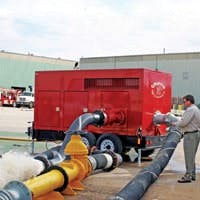The past decade has ravaged Florida from its panhandle to the Keys, with five major hurricanes. In 2010, the city of Tallahassee determined that, for several of its master sanitary pump stations, adequate backup pumping capacity was necessary to continue basic services during the types of power outages that the hurricane seasons of previous years had brought. As a result, the city of Tallahassee developed a specification for a pump system to help address its needs.
Several major pump manufacturers answered Tallahassee’s call, but when it came to the final review, Griffin Pump & Equipment was chosen to produce the new pump package. A variable-use, non-clog pump was selected to handle the flow and head conditions provided in the specification and to address the solids-handling requirements at the pump station. The stated conditions were an operating point of 5,000 gal per minute (gpm) at 230 ft total dynamic head (TDH).
The company proposed the use of its Model 12NCCD variable usage, non-clog, vacuum-primed 12-in. centrifugal pump. The city requested that a Department of Transportation trailer package enabling over-the-road transport of this 15,000-lb pump package and a sound attenuation enclosure for noise code-compliant use in residential areas be provided for the unit.
Sound attenuation for a 400-hp diesel engine is a challenge, but in this case it was realistic, with sound-level readings of below 80 decibels at 20 ft horizontal distance. As a point of reference, 80 decibels is in the sound level range of an adult male’s normal speaking voice. The application’s sound package included an enclosure with acoustic foam, an intake air hood and a sound-reducing muffler system. A containment pan to collect any fluids from the engine, tank and pumping operations also comes standard. The enclosure was fabricated with multiple doors to allow for ease of maintenance.
As part of the specification, a field demonstration was required. Master Pump Station No. 74 on Weems Road in Tallahassee was selected as the most critical of the problematic pump stations.
Its wet well, at 40 ft deep, along with its everyday sewage volumes plus infiltration of an unknown quantity, required that 7,000 gpm of raw sewage be bypassed at pressures of up to 80 psi.
Subsequent to the initial training of Tallahassee’s field staff in the operation and maintenance of the new unit, the city requested that a second booster pump be designed and provided to boost the discharge volume even more. Due to the extreme depths of neighboring lift stations and levels of the influent lines into the lift station, it was determined beneficial to be able to lower Pump Station No. 74 to lower elevations more than 15 ft of depth (exceeding typical suction lift limits of centrifugal pumps).
This additional depth requirement was intended to minimize or eliminate the possibility of neighboring pump stations supplying Pump Station No. 74 from overtopping.
Griffin offered to supply and test its Model 825HPND/12T (12-in.) hydraulically driven submersible trash pump system that also was provided trailer mounted with a sound attenuation enclosure. The pump was set at the bottom of the pump station and piped directly into the centrifugal pump, which was placed at top of ground. Upon testing, this combination “push-pull” pump system successfully produced volumes exceeding 8,000 gpm in excess of 80 psi.
For the Long Run
The utility was able to develop a combined system that combined the benefits of a hydraulic submersible pump with a dry-priming centrifugal package. The submersible pump allows for the elimination or reduction of a suction lift and provides high flow rates. Also, because the hydraulic submersible pump is fabricated, it is anticipated to provide good wear resistance and long life. The variable-use, non-clog pump produces a high flow rate and is capable of pumping against high pressures. It also will allow for a system to achieve prime without having to add any water to the wet end.
Another key benefit is that there now are two systems that can be used independently on less stringent sites or combined to handle the more difficult conditions. Both systems were required to be portable and easy to install so that city crews could set up the system in emergency conditions without requiring a significant amount of equipment.
The new pumping equipment should provide the city with hurricane power outage peace of mind for years to come.
“Through careful coordination between the city of Tallahassee and Griffin Pump & Equipment’s staff, the system performed well and met the city’s expectations,” said Eric Etters, program engineer with the city of Tallahassee.
Download: Here

